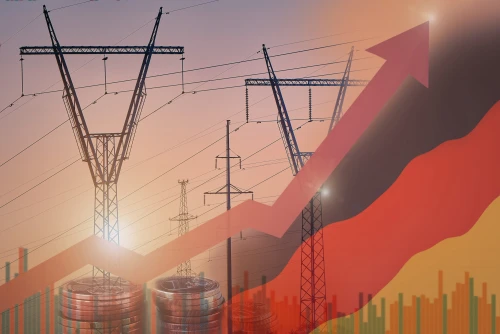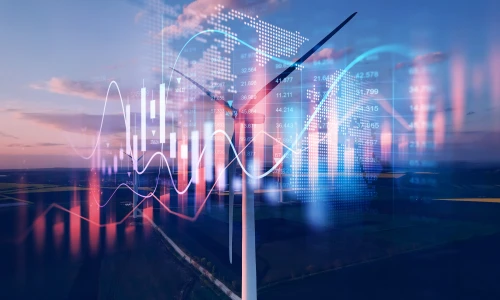
April 24th, 2025
Join our Italian Energy Day on 20 May – Book now
As the world shift towards sustainable energy, hydrogen is becoming an increasingly vital player in the clean energy landscape.

Hydrogen's versatility and potential for zero-emission energy make it a promising solution for industries ranging from transportation to manufacturing. However, the cost of hydrogen production remains a significant factor influencing its widespread adoption.
We take a look at hydrogen production cost trends predicted for 2025, examining technological advancements, market dynamics, and regional variations that could shape the future of this critical energy source.
Hydrogen production costs vary significantly depending on the method used. The three primary types of hydrogen are green, blue, and grey hydrogen, each with distinct production processes and associated costs:
Grey Hydrogen is produced from natural gas through steam methane reforming (SMR) without capturing the resulting carbon emissions. It’s currently the cheapest form of hydrogen, costing approximately €1 to €2 per kilogram.
Blue Hydrogen also uses SMR but incorporates carbon capture and storage (CCS) technologies to reduce emissions. This process makes blue hydrogen more expensive, typically costing between €1.50 and €3 per kilogram.
Green Hydrogen is produced through electrolysis, using renewable energy to split water into hydrogen and oxygen. It is the most sustainable but also the most expensive, with costs ranging from €3 to €7 per kilogram, depending on renewable energy prices and electrolyser efficiency.
In 2024, the hydrogen industry saw incremental cost reductions, especially in green hydrogen, due to advancements in electrolysis technology and increased renewable energy capacity. However, further cost declines are essential for hydrogen to become a mainstream energy solution.
Several factors will influence hydrogen production costs in 2025, with a focus on technology, policy, and market dynamics.
Improvements in electrolyser technology are crucial for reducing green hydrogen costs. Innovations in materials, such as using cheaper and more abundant catalysts, are expected to lower capital costs and enhance efficiency.
As production scales up, economies of scale will help decrease costs. Large-scale hydrogen plants and integrated renewable energy projects are anticipated to drive significant cost reductions.
Many governments are offering subsidies and tax incentives to promote green hydrogen production. The U.S. Inflation Reduction Act and the European Union’s Green Deal are examples of policies that could significantly lower costs by 2025.
Stricter emissions regulations and carbon pricing will make grey hydrogen less competitive, indirectly boosting demand and cost competitiveness for blue and green hydrogen.
The cost of renewable energy is a major factor in green hydrogen production. As solar and wind energy prices continue to fall, the overall cost of green hydrogen will decrease.
Efficient integration of hydrogen production with renewable energy grids and advancements in energy storage will further optimise production costs.
Building and maintaining hydrogen pipelines and storage facilities are critical to reducing overall costs. Investments in infrastructure will help lower transportation expenses and improve supply chain efficiency.
New storage solutions, such as solid-state hydrogen storage, could reduce costs and improve safety, making hydrogen more viable for widespread use.
Hydrogen production costs are expected to vary significantly across different regions due to differences in energy resources, policies, and infrastructure.
The EU is heavily investing in green hydrogen as part of its commitment to achieving net-zero emissions by 2050. With strong policy support and access to renewable energy, green hydrogen costs in the EU are projected to decline substantially by 2025.
The U.S. has vast natural gas resources, making blue hydrogen a competitive option. However, federal incentives for green hydrogen under the Inflation Reduction Act are expected to make green hydrogen increasingly cost-competitive.
Countries like Japan and South Korea are leading the hydrogen charge, focusing on importing hydrogen due to limited domestic renewable resources. Australia, with its abundant solar and wind resources, is emerging as a major hydrogen exporter, potentially offering some of the lowest green hydrogen prices by 2025.
Green hydrogen is poised to see the most significant cost reductions in 2025. As electrolysis technology advances and renewable energy becomes cheaper, green hydrogen production costs could fall below €2 per kilogram in regions with abundant renewable resources. This price point is critical for green hydrogen to compete with fossil fuel-based hydrogen and other energy sources.
Blue hydrogen costs are expected to stabilise or slightly decrease as carbon capture technologies improve and economies of scale are realised. However, its future competitiveness will depend on the stringency of carbon pricing and emissions regulations. If policies favour low-carbon solutions, blue hydrogen will remain a viable transitional energy source.
The future of grey hydrogen looks uncertain due to increasing environmental regulations and carbon pricing. While it remains the cheapest option today, its cost advantage will diminish as the world moves towards decarbonisation. By 2025, grey hydrogen may face significant challenges in markets with stringent emissions targets.
The projected cost trends for hydrogen production in 2025 will have far-reaching implications for various industries and the global energy market.
Lower hydrogen costs will accelerate the adoption of hydrogen fuel cell vehicles, especially in heavy-duty transport sectors like trucking, shipping, and aviation.
Industries such as steel manufacturing, chemical production, and refining will benefit from affordable hydrogen as a clean energy source, helping them reduce carbon emissions.
Hydrogen’s role in energy storage and grid stabilisation will expand as costs decline, supporting the broader integration of renewable energy.
The declining costs of hydrogen production will attract more investments in hydrogen infrastructure, technology development, and renewable energy projects, fostering economic growth and innovation.
Hydrogen production costs are expected to decrease significantly by 2025, driven by technological advancements, supportive government policies, and declining renewable energy prices. Green hydrogen, in particular, is set to become more competitive, paving the way for a cleaner, more sustainable energy future. As industries and governments continue to invest in hydrogen technologies and infrastructure, the world moves closer to realising hydrogen’s potential as a cornerstone of the global energy transition. Staying informed about these cost trends will be crucial for stakeholders across the energy sector, from policymakers and investors to technology developers and environmental advocates.
Get accurate insights into the future price of green hydrogen for the German market.

April 24th, 2025

April 23rd, 2025

April 22nd, 2025